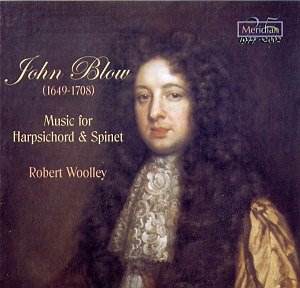This generously filled disc comes in Meridian’s
25th Anniversary series 1977-2002 in which the company
are taking some of their highlights from that period. This music
was originally recorded in 1981/2 and, presumably gauging from
its length, featured on two LPs. No details are given and I cannot
remember that far back!
John Blow was a very prolific composer of keyboard
music. He was Purcell’s teacher but outlived him by thirteen years.
As can be seen, almost all of this music post-dates his pupil’s
premature death. The selected pieces fall into different categories.
The most substantial category is the ‘Sett’. Each Sett consists
of three unrelated pieces of various sorts but normally including
an Alman and a Sarabande. It’s interesting to turn, as I did again,
to Purcell’s eight suites for harpsichord and compare these. Purcell
bases his works more on the French model with at least four movements,
including a rather stiff and dotted Alman, as was usual. Purcell
always begins a suite with a freewheeling Prelude, rather as a
renaissance lutenist would do, effectively loosening the fingers
and establishing a key. Blow’s Preludes are quite separate pieces;
one begins the CD the other, curiously, almost ends it.
Purcell’s suites were compiled and published
by his wife in 1696, the year after he died. With Purcell it is
possible to see stylistic development. It is as if some were written
when Purcell was quite young, from the simple first suite which
most young musicians can tackle to the decidedly more complex
later ones. In this latter category I include, for example, the
Prelude to Suite VI which has distinctly Scarlatti-like two-part
counterpoint. Purcell beats Blow every time in his passion, fecundity
and ideas. For both composers the Sarabande and Alman are binary
structures with each half repeated. The question of possible ornamentation
for the repeat arises. The otherwise excellent Robert Woolley
does not include any, possibly on the grounds that Blow’s melodic
lines are often ornamented enough anyway. However I’m not sure
that he solves the problem of keeping the interest going in some
dances without this added variation.
I have commented in previous reviews that I so
wish that record companies and/or performers would enlighten us
as to editions used for the recording. Meridian sadly leaves us
utterly in the dark on this front. I am therefore rather puzzled
by Woolley’s attitude towards repeats. I have an edition of some
of these pieces by Blow published by Schirmer and edited by Richard
Aldrich (Early Keyboard Music Vol. 1). Now I agree that it is
not the most reliable of editions but if we take one work, say
the Chaconne in G minor, we find it composed over a similarly
repeated bass line in four bar phrases. Aldrich’s edition indicates
no repeats at all, but one feels that they are really necessary.
Woolley repeats some four bar phrases but not all. This leaves
this listener, at least, feeling a little unbalanced. In another
piece the Ground in G major (KL5), Schirmer’s edition indicates
repeats of each of the unusual five bar phrase lengths. There
is even a change of time signature at one point, and it is a good
idea I think. Woolley observes none of these.
With Blow there is no sense of development from
Setts 1 to 5 and the publication dates (1698/1700) may even indicate
that some pieces had been composed quite a few years before …
possibly whilst his more famous pupils was alive.
As well as these Setts, Woolley has recorded
four pieces called Grounds and as mentioned, two Chacones (sic).
Both utilize repeated bass patterns although the Chaconne is more
subtle and may just use the implied harmony. There are also some
theatre tunes from 1689.
The instruments are carefully chosen and used.
They are also illustrated, helpfully in colour, in the booklet
and their background given. The ‘bentside’ Spinet (which is deliberately
and elegantly curved) is by Charles Haward 1689, and on the whole
is given the lighter pieces to play and it is a gentler lighter
instrument. The beautiful harpsichord from the Cobbe Collection
is dated 1623. So the Spinet is given the delightful Air and Minuet
and the Theatre pieces for example and the harpsichord given the
serious and powerful Chacones and Grounds.
Gary Higginson
